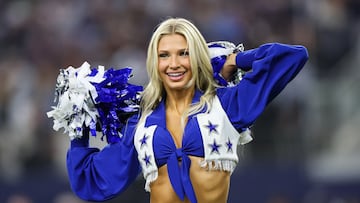
Cheerleaders have been a fixture in the NFL for over 60 years, since the 1954 season when the Baltimore Colts became the first team to introduce them at games. Since then, the practice of game-day cheerleaders has evolved to become an integral part of the NFL. Cheerleaders have become a prominent part of marketing and merchandising, and many regularly perform overseas for U.S. Armed Forces personnel through the United States Organizations Inc.
What’s the deal with cheerleaders today?

Despite the prominence of cheerleading in the NFL, there has traditionally been a huge disparity in terms of pay. According to figures compiled by Sportskeeda, junior cheerleaders make less per year ($20,000) than an NFL mascot ($25,000) and considerably less than an NFL waterboy ($53,000). The standard pay for a cheerleader is $150 per home game and around $50-75 for public appearances on behalf of the franchise, which can include school visits, conferences, and corporate events.
Some cheerleaders are professional, and they can make up to $75,000 a year. However, the large majority are not and are either in college or have just graduated. Many only remain in the NFL for a few years, and those who do earn a higher salary generally have years of experience in senior positions within the cheerleading squad, and may also have represented several different teams. In general, senior cheerleaders receive larger matchday fees than rookies and can also earn more in bonuses.
At present, cheerleading remains a popular part of the sport, but it would be dishonest to say that it doesn’t have its detractors. Consider for a moment that as recently as 2021, there were still seven teams among the league’s 32, that did not feature a cheerleading squad: Buffalo Bills, Chicago Bears, Cleveland Browns, Green Bay Packers, New York Giants, Los Angeles Chargers, and Pittsburgh Steelers.
Why do NFL cheerleaders earn so little?
:max_bytes(150000):strip_icc():focal(999x0:1001x2)/dallas-cowboys-cheerleaders-1-b6f817c895914dcaa59e6d7b56e8bd59.jpg)
Technically the reason for this is because cheerleaders for the NFL, and the NBA for that matter, are independent contractors. This means the teams are not necessarily required to pay the cheerleaders salaries in line with state and federal minimum wages. As a result, NFL cheerleaders, who used to earn as little as $5 per hour at one point in time, have been posing a fight for decades. In 2021, a series of lawsuits brought about by these cheerleaders caused 10 out of 26 NFL teams to be sued for wage theft, unsafe working conditions, sexual harassment, and discrimination.
The lawsuits included teams such as the New York Jets, the Buffalo Bills, the Cincinnati Bengals, and the Tampa Bay Buccaneers. The Tampa Bay cheerleaders’ lawsuit settled for a reported $825,000, and the Cincinnati cheerleaders’ settled for a reported $255,000, according to the Expert Institute. Since then, a national conversation erupted involving the exploitation of women in sports, and now cheerleaders are respected and paid a bit more – but still not as much as they should be.
So, do any cheerleaders get paid well?
Yes, some do. To put things in perspective, the highest-paid cheerleaders generally earn around $500 per game. The highest-paid cheerleaders in the league are the squads for the Miami Dolphins, Minnesota Vikings, New England Patriots, and Philadelphia Eagles, all of whom earn between $15-20 an hour and $500 per game.
Thanks to a court case led by former DCC Erica Wilkins, the Cowboys cheerleaders now earn a much higher wage than they did in the past.Known as “America’s Sweethearts”, the Cowboys cheerleaders are among not just the most popular in the NFL, but sports across the nation in general, and the expectations placed on them are extremely high. Before the court case, Cowboys cheerleaders earned an hourly wage of $8, less than the minimum wage. Now, they are paid an hourly rate of $12 and receive $400 per game. The more experienced, senior-level cheerleaders reportedly even earn around $75,000 annually.
Despite the increase in pay and huge responsibility that comes with being on the squad, being a Cowboys cheerleader is still just a part-time job for most of the members. Many of them have full-time careers in various positions in order to maintain a living wage. A 1989 DCC alum Tina Kolina explained that the Cowboys cheerleaders of today do look at the position as more of a job, while “us old-timers [looked] at it as more of a privilege.”






